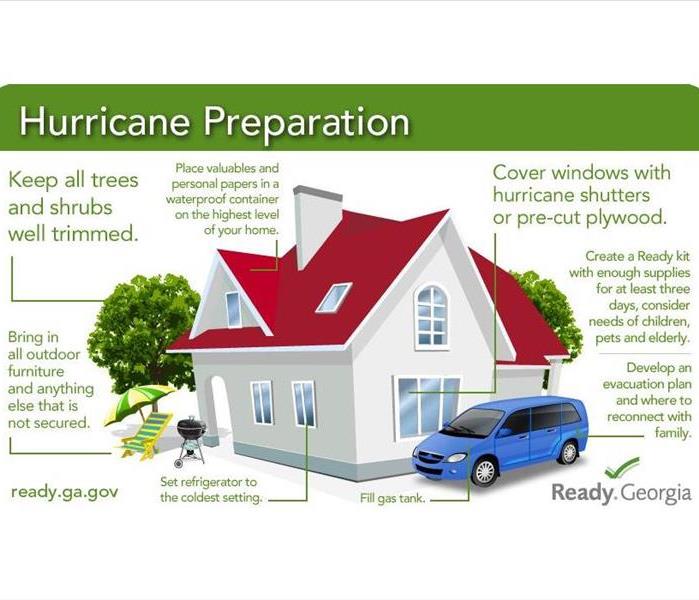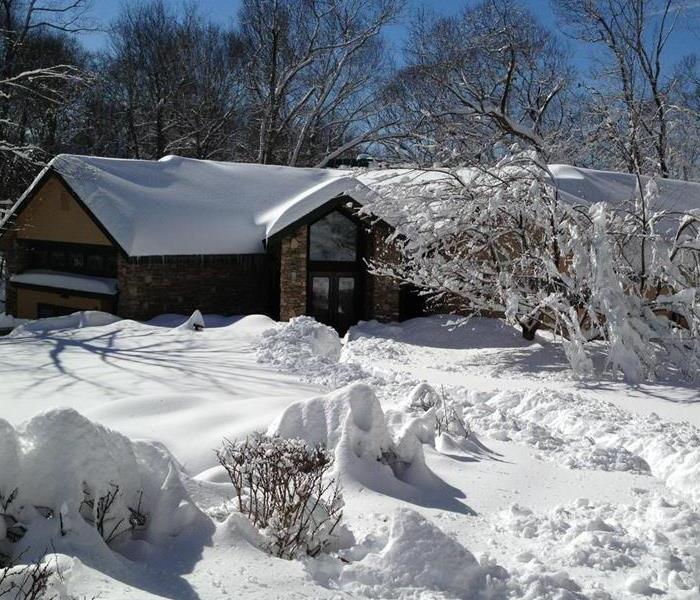Recent Storm Damage Posts
Fire season- The supply chain could be affected
6/28/2022 (Permalink)
SERVPRO of Benicia/ Martinez/ Southeast Vallejo is here to help. 925/372-7234
Supply chain disruptions can occur, especially if wildfires burn across highways and roads or approach large population centers. Wildfires can also lead to evacuations, road closures and ground transport diversions. Disruptions to arterial roads and the scarcity of alternative routes in some areas means that significant transport disruptions will increase. Roads in remote regions are likely also to be disrupted for longer periods than urban roads due to their relative inaccessibility.
Low visibility from smoke and possible ashfall could contribute to traffic delays and congestion and prompt short-notice flight disruptions if wildfires occur near airports. Railways can also experience occasional cancellation of services and long delays.
SERVPRO of Benicia/ Martinez/ Southeast Vallejo is always a phone call away when fire or smoke impacts your personal or professional life. 925/372-7234
Fire season- What to expect this year.
6/22/2022 (Permalink)
SERVPRO of Benicia/ Martinez/ Southeast Vallejo is here to help. 925/372-7234
Wildfires can result in loss of life or impact public health, cause environmental, property and infrastructure damage, as well as effect economic losses. Besides increasing air pollution, smoke from wildfires can hurt the eyes, irritate the respiratory system, and worsen chronic heart and lung diseases. Smoke may also worsen symptoms for people with pre-existing respiratory or heart conditions. People and wildlife may also suffer burns and trauma.
Increased soil erosion is likely across burn scars during bouts of rainfall due to loosened soil and loss of vegetation. Power outages are possible in places due to damaged substations and transmission lines. Intentional power cuts may also be necessary to prevent infrastructure damage or help in preventing the spread of fires.
Whatever fire season brings SERVPRO of Benicia/ Martinez/ Southeast Vallejo is here for you just a phone call away 925/372-7234
Before a Wildfire
6/6/2022 (Permalink)
SERVPRO of Benicia/Martinez/SE Vallejo is here to help at 925/372-7234
What to do BEFORE a Wildfire:
Create defensible space to separate your home from flammable vegetation and materials (minimum 30 ft)
Adhere to all local fire and building codes and weed abatement ordinances.
Keep all trees and shrub limbs trimmed so they do not come into contact with electrical wires or overhang your chimney (Do not trim around power lines yourself, call a professional).
Prune all lower branches 8 feet from the ground.
Keep trees adjacent to buildings free of dead or dying branches.
Stack firewood away from your home and other buildings (Keep clearance around your piles).
Keep roof surfaces clear of pine needles, leaves and debris at all times.
Clean chimneys and check and maintain spark arresters twice a year.
Keep rain gutters clear of debris at all times.
Use approved fire resistant materials when building, renovating or retrofitting structures.
Be sure your house numbers show clearly from the street, both day and night.
Store combustible or flammable materials in approved containers.
Store all important papers in a fireproof container or keep copies at another location.
Make evacuation plans with family members. Include several options with an outside meeting place and contact person. Practice regularly.
Keep battery operated radios and flashlights with additional fresh batteries on hand.
During a Wildfire
6/2/2022 (Permalink)
For all of your restoration needs call SERVPRO of Benicia/Martinez/SE Vallejo at 925-372-7234
What to do DURING a Wildfire:
Turn on a TV or radio to get the latest emergency information.
If you have a ladder, prop it against the house so you and firefighters have access to roof.
If hoses and adequate water are available set them up. Fill buckets with water.
Remove combustible material from the area surrounding the house (lawn chairs, tables, etc.).
Turn a light on in each room for visibility in case of smoke.
Open or take down flammable drapes and curtains.
Close all venetian blinds and non-flammable window coverings.
Move upholstered furniture away from windows and sliding glass doors.
Be ready to evacuate all family members and pets when requested to do so.
Turn off air conditioning/air circulation systems
Detach electrical garage doors. Back in your car and leave the keys in the ignition.
Secure your pets if possible.
California Wildfires
5/24/2022 (Permalink)
SERVPRO of Benicia/Martinez/SE Vallejo 925-372-7234
Wildland firefighters don’t admit to fearing much, but lightning is one terror that even the most experienced veterans say they hope to never encounter.
The worry is not being struck by a bolt, although it can be deadly. Instead, their primary concern is that lightning, slashing down in remote areas, can trigger unseen fires that smolder for days before they flare up, bursting into a dangerous and difficult-to-fight wildfire.
In August 2020, a remarkable barrage of lightning in Central and Northern California spawned more than 15,000 strikes over a few days, igniting more than 600 fires and burning more than 2 million acres. Five simultaneous lightning-sparked fires destroyed thousands of homes and buildings and claimed the lives of at least seven people.
Fire Storms the new Normal
5/24/2022 (Permalink)
SERVPRO of Benicia/Martinez/SE Vallejo is always here to help, we are just a phone call away at 925-372-7234. Creating an action plan like the one below can help in an emergency, create one for your family today.
CREATE A WILDFIRE ACTION PLAN
Your Wildfire Action Plan must be prepared, and familiar to all members of your household well in advance of a wildfire. Use the checklist below to help create your plan. Each family’s plan will be different, depending on a variety of issues, needs, and situations.
Ensure you plan with COVID-19 in mind. Ask friends or relatives outside your area if you would be able to stay with them, should the need arise. If you do need to evacuate and plan to stay with friends or relatives, ask first if they have symptoms of COVID-19 or have people in their home at higher risk for serious illness. If that is the case, make other arrangements. Check with hotels, motels and campgrounds to learn if they are open. Also get set by learning about your community’s response plan for each disaster and determine if these plans have been adapted because of COVID-19.
Your Wildfire Action Plan Checklist
Create an evacuation plan that includes:
- A designated emergency meeting location outside the fire or hazard area. This is critical to determine who has safely evacuated from the affected area.
- Several different escape routes from your home and community. Practice these often so everyone in your family is familiar in case of emergency.
Firestorms
12/8/2020 (Permalink)
Firestorms are caused by a wildfire, or multiple wildfires in the same area. The heat from a wildfire can create its own wind system which can lead to strange weather effects.
Wildfires can be started from many sources, such as a lightening strike, downed power lines, an unattended campfire and sometimes even arson.
Firestorms form for two main reasons:
- Hot air rises.
- Nature does not like a vacuum, or empty space.
That means empty spaces will not stay empty for long. It all starts because heat is constantly and quickly rising from the fire. As all this heat and air moves upwards, it leaves behind some empty space. Air from all around the fire rushes in to fill that gap. That movement of air creates a powerful wind called an updraft.
If the fire is big enough, it will form a "fire storm cloud." These can produce lightning, which could set off even more fires. They also generate stronger winds, which fan the fire, making it hotter and helping it spread.
Scientists are now studying fire weather, to better understand how to control wildfires once they begin.
When a storm comes through. What do you do?
7/21/2020 (Permalink)
When a storm sweeps through your local community, you may find yourself afraid, anxious, and unsure of where what to do next. You may worry about the time and energy it will take to pick up mess, how to identify areas effected, and how to prioritize all necessary repairs. You might even worried about the costs associated with extensive home repairs. SERVPRO of Benicia/Martinez/Southeast Vallejo specializes in storm damage repair!
What you can expect the following storm and flood damage services from our team:
We will assess the structural integrity of your home
We will assess the extent of the damage
We will determine the necessary repairs
We will execute a proper cleaning and repair action plan to get your home or business back up and running.
SERVPRO of Benicia/Martinez/Southeast Vallejo specializes in the cleanup and restoration of residential and commercial property after a fire, smoke or water damage event. Our staff is highly trained in property damage restoration and we are an IICRC Certified Firm. We believe in continuous training: from initial and ongoing training at SERVPRO’s corporate training facility to regular IICRC-industry certification, rest assured our staff is equipped with the knowledge to restore your property.
Have Questions about your storm damage?
Call Us Today – 925-372-7234
When Storms or Floods hit SERVPRO is ready!
7/9/2020 (Permalink)
SERVPRO of Benicia/Martinez/Southeast Vallejo specializes in storm and flood damage restoration. Our crews are highly trained and we use specialized equipment to restore your property to its pre-storm condition. Our teams are truly prepared to handle "any size disaster." With a network of over 1700 locations nationwide, our teams are ready to mobilize at a moments notice to get your business back up and running.
Faster Response
Since we are locally owned and operated, we are able to respond quicker with the right resources, which is extremely important. A fast response lessens the damage, limits further damage, and reduces the restoration cost.
Resources to Handle Floods and Storms
When storms hit we can scale our resources to handle a large storm or flooding disaster. We can access equipment and personnel from a network of 1,650 Franchises across the country and elite Disaster Recovery Teams that are strategically located throughout the United States.
Have Storm or Flood Damage? Call Us Today 925-372-7234
Is Your Business Ready for Disaster?
3/24/2020 (Permalink)
Disasters happen, whether it is a storm event or a burst pipe in your building. Large or small, it can deeply impact your business. Did you know that half of all businesses that close for disasters never open their doors again.
What is the difference between those who reopen and those who do not? Those who reopened had an emergency plan already in place. Don’t be one of those 50% who cannot reopen their doors. Let SERVPRO Of Benicia/Martinez/Southeast Vallejo help you set up an Emergency Ready Plan.
The first step in successful mitigation is knowing who to call and starting the process as quickly as possible. Water or smoke that sits too long can begin to damage your belongings. Your Emergency Ready Plan will include, water and gas shut off locations, primary contact information from everyone to the building owner to your plumber, insurance information, and an evacuation plan for your facility.
Contact SERVPRO Of Benicia/Martinez/Southeast Vallejo today and schedule your free E.R.P. today!
CA Wildfires & Planned Power Outages
10/29/2019 (Permalink)
To help control the risk of wildfires in Northern California PG&E has planned power shutoffs when there are gusty winds and dry conditions. If you have been notified that your home will be affected by a planned electric outage here are some steps you can take to reduce the impact of the outage.
- Keep important phone numbers in a convenient location in case you need emergency or other assistance.
- Have a back-up plan to maintain life-support equipment if you have it.
- Keep a cell phone or hard-wired telephone on hand.
- Keep a flashlight with extra batteries in a convenient place.
- Turn off heat-producing appliances such as stoves, ovens, and irons prior to the outage.
- Protect sensitive electronic equipment by unplugging them.
- Make sure you can manually open your garage door if it is automated.
- Make sure food stays cold by keeping your refrigerator doors closed.
- Notify your alarm company as the equipment can be affected by outages.
- Keep on hand perishable foods that don’t require cooking.
- Inform PG&E if you have a generator.
It can be an inconvenience to be without power for days at a time but with proper planning you can ease some of the impact on you and your family.
Before Thunderstorms and Severe Weather
9/19/2019 (Permalink)
How To Prepare for Thunderstorms
When we think about storms most think of rain, hurricanes or windstorms. Not many think of thunderstorms. Here are some tips to prepare if a thunderstorm is on the horizon.
- Learn about your local community's emergency warning system for severe thunderstorms.
- Discuss thunderstorm safety and lightning safety with all members of your household.
- Put together an emergency preparedness kit.
- Pick a safe place for household members to gather during a thunderstorm. This should be away from windows, skylights and glass doors that could be broken by strong winds.
- Protect your animals by bringing them indoors.
- Make a list of items to bring inside in the event of a severe thunderstorm.
- Consult your local fire department if you are considering installing lightning rods.
- Get trained in first aid and learn how to respond to emergencies.
- Make trees and shrubbery trimmed and remove damaged branches to keep them more wind resistant.
Youth Preparedness
9/10/2019 (Permalink)
Emergencies and disasters can happen at any time, often without warning. Disaster planning, response, and recovery efforts must take into account the unique needs of children, who make up roughly a quarter of the U.S. population. These efforts should also engage the unique strengths children bring to emergency preparedness.
- Children are positive influencers. Children can effectively bring the messageof preparedness home to their families.
- Children can become leaders. Participating in youth preparedness programsempowers children to become leaders at home and in their schools and communities.
- Children can be confident during an emergency. Children who are preparedexperience less anxiety and feel more confident during actual emergencies and disasters.
Starting or getting involved with a youth preparedness program is a great way to enhance a community’s resilience and help develop future generations of prepared adults.
The Federal Emergency Management Agency offers numerous resources that can help.
NATIONAL STRATEGY FOR YOUTH PREPAREDNESS EDUCATION
Developed by FEMA, the U.S. Department of Education, and the American Red Cross, the National Strategy for Youth Preparedness Education presents nine steps partners can take tohelp build a Nation of prepared youth. The steps focus on building partnerships to enhanceyouth preparedness learning programs; connecting young people with their families,communities, first responders, and other youth; and increasing preparedness at school.
START A YOUTH PREPAREDNESS PROGRAM
Anyone can start a youth preparedness program. Establishing one takes effort, but many resources are available to help. Youth Preparedness: Implementing a Community Based Program presents seven steps to start and sustain a program.
Earthquake Safety Tips
5/3/2019 (Permalink)
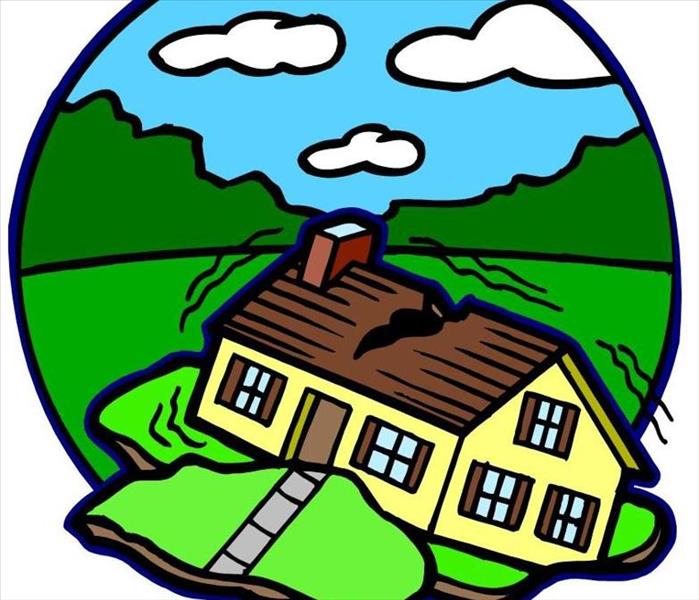 Always be ready for an Earthquake.
Always be ready for an Earthquake.
We all know that an earthquake can hit at any given moment. That is why it is very important that we are always prepared to deal with it if it happens in our area. Below are some tips on how you can prepare yourself, family, employees, or students:
- Have an earthquake kit ready; fill with non perishable foods, spare clothes, first aid kit, water, flashlights, battery operated radio, and even something that will comfort you or your the little ones like a blanket or stuffed animal.
- Have an evacuation plan ready that includes a safe exit and safe meeting place. Also have a list of all who will be meeting at the meeting place so you can make sure everyone has made it safely.
- Have a plan ready if you are unable to evacuate. Find a safe spot in every room of the building or home. Practice duck and cover often so everyone is ready in the event that an earthquake strikes.
- If you are in a car when an earthquake strikes; slow down and drive to a place clear of trees, buildings, telephone polls, etc. Stay in the vehicle until earthquake's over.
The Heat is Coming
5/3/2019 (Permalink)
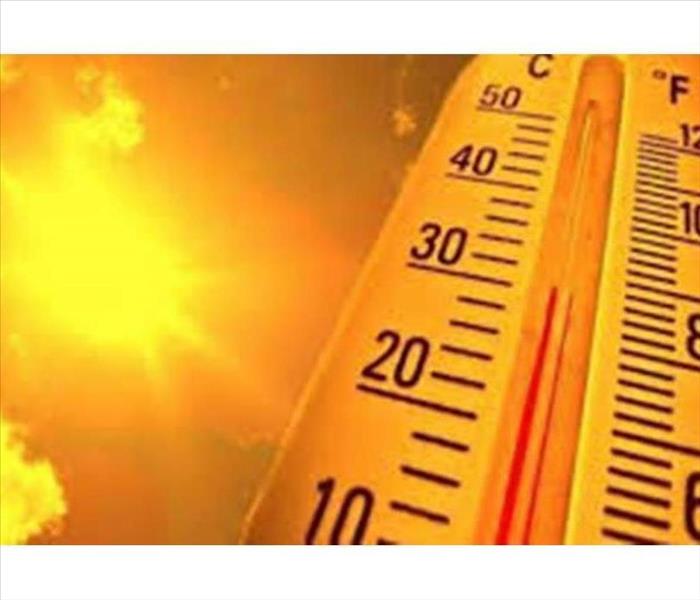 The Heat is rising, be prepared!
The Heat is rising, be prepared!
We had a pretty cold and long winter, but I think it is safe to say the heat is on and it's not even summer time yet! Guessing by how hot it is getting already, this summer is going to be a scorcher. We all need to be aware of the dangers of heat and be prepared for it. Excessive heat has caused more deaths than all other weather catastrophes, even floods. Heat holds the highest 10 year average of deaths with 113. Young, sick children and the elderly are more susceptible to illness caused by heat. But, that doesn't mean that the rest of us are safe from it, if you do not properly follow tips and tricks to avoid heat stroke, you could fall victim to it as well. Follow the link below to see tips on how to prepare for and prevent illness from heat waves:
https://www.almanac.com/content/heat-waves-10-tips-extreme-heat-safety#
The Aftermath...
3/14/2019 (Permalink)
Thankfully, the Campfire Wildfire is officially over.. but it left the cities in the area in bad shape. This photo is just another glimpse of how the cities were left..The once green hills were burnt to almost nothing and were left looking black. The house in the photo was under construction before the wildfire and was luckily still standing after all of the damage that was done. It did suffer some smoke and soot damage. That is where we came in , cleaned up, and headed out. Headed to the next home that was is need of our services. We definitely traveled the distance to help all of the residents that we could and of course our fellow SERVPRO in Chico. We will definitely continue to help when disasters strike again. We go above and beyond to do what we can, and always will. So, never fear, SERVPRO will always be near and ready to help!
Protect Yourself From Wildfire Smoke
10/8/2018 (Permalink)
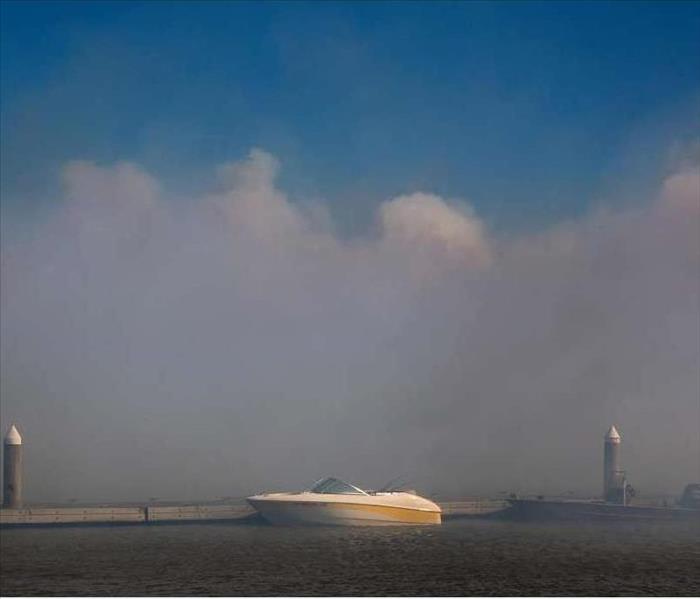 The smoke rising into the sky as the wildfire burned through thousands of acres in Solano County.
The smoke rising into the sky as the wildfire burned through thousands of acres in Solano County.
As some of you may know, there was yet another large fire yesterday in Solano County. The wildfire burned more than 4,000 acres of land and was 70% contained as of last night. Luckily, there were no fatalities or injuries.
Most of us could see and smell the smoke spreading through the air. The smoke is made up of small particles, gases, and water vapor. The remainder includes carbon monoxide, carbon dioxide, nitrogen oxide, irritant volatile organic compounds, and air toxics.
Some may be more sensitive to the smell than others, either way, it is best to avoid inhaling smoke if you can help it. The smoke can cause a headache or irritate your eyes, nose, throat, and lungs.
The biggest health threat from the smoke is from the fine particles that it carries. These particles can penetrate deep into your lungs. Your lungs and airway may become swollen, irritated, and blocked. This could prevent oxygen from getting into your blood and respiratory failure may develop. With that being said, you can see why it is very important to avoid inhaling the smoke.
You can reduce wildfire smoke exposure by staying indoors, keeping windows and doors closed, and running your HVAC system on the recirculating setting. Avoid activities that increase indoor pollution. Wearing a mask called a "particulate respirator" can also help protect you. Also, be sure to check local air quality reports and local visibility guides so that you are aware of what actions you need to take, if any, to avoid smoke inhalation.
The Rain is Coming
9/28/2018 (Permalink)
We have all had a great summer enjoying the beautiful clear skies and sunny days. Unfortunately, that has almost come to an end. Now we need to get ready for the rain. Water damage isn't limited to rain but rain is definitely a cause. Before it starts to pour take precautionary measures to keep the rain out of your home to prevent a water loss.
Your roof's primary purpose is to keep water out of your house. neglecting it could lead to a whole lot of problems.
Windows and doors are common vulnerable areas for water leakage. Water can seep through the space around window and door frames if they're not properly sealed.
- Maintain Your Home's Exterior Finish
Periodically inspect your exterior walls and look for signs of damage such as holes, wood rot, or warping. If caught early enough, you may be able to clean out the wet materials and repair the affected. (SERVPRO can help with that!)
Make sure your gutters are properly functioning and clean. It is critical to do so as it protects your home from water damage. (SERVPRO can help with that!)
You can always take measures to keep water out of your home but if water isn't properly diverted away from the base of your home, your foundation could be at risk.
Functioning gutters send water out through a downspout, which funnels the water from your home. If the downspout does not extend far enough, it could funnel directly into a puddle at the bottom of your house thus flooding your crawlspace. (SERVPRO can help with that!)
If your home sits on the bottom of a slope, water runoff from your yard should be redirected away from your home. If it is not, then you will most likely have problems with standing water near your foundation. This could cause the ground near your foundation to erode overtime, making it vulnerable.
Be sure to waterproof your home before it leaks into bigger problems. And remember who to call in case the water still makes it's way in ...
SERVPRO of Benicia/Martinez/SE Vallejo!
Prepare your Pets for Emergencies
9/13/2018 (Permalink)
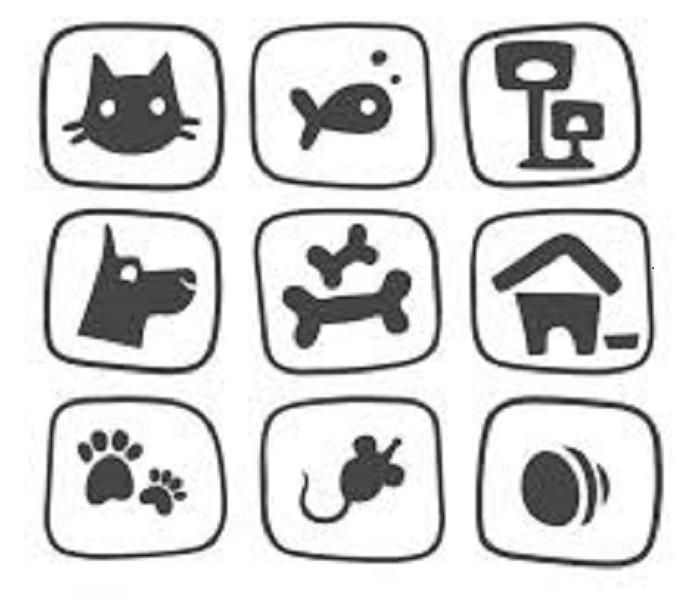 Have a plan for your pets in case of a disaster.
Have a plan for your pets in case of a disaster.
Every disaster plan must include your pets. If you know disaster is imminent, bring your pet inside immediately. Get your animals under control as quickly as possible, either using a leash or by putting them in a pet carrier.
Disasters often strike suddenly, while you are away from home. You can improve your pet’s chances for safety if you leave him/her inside, with collars and identification tags, when you go out. Consider an arrangement with a trusted neighbor who would be willing to evacuate your pets in your absence. Make sure the person knows your animals, can locate your emergency supplies, and has a key to your home. Provide him or her with instructions and phone numbers on how to reach you.
Keep up-to-date identification on your pets at all times. Use a properly fitting collar with an identification tag. Consider using a microchip for identification, but make sure local shelters have microchip scanners. Keep current color photographs of your pet, showing any distinguishing markings, with your emergency supplies.
If you evacuate, take your pet. Your animal’s best protection is to be with you. Remember, taking your pet with you requires special planning. Locate a safe place for your pets before disaster strikes. Evacuation shelters generally do not accept animals for public health and safety reasons. Service animals, on the other hand, are allowed to accompany their owners to an emergency shelter. Call hotels and motels in your immediate area and a reasonable distance from home to see if they will accept pets and under what conditions. Also, contact local boarding kennels and veterinary hospitals with boarding facilities.
Assemble a portable pet emergency supplies kit to provide for your pet’s needs for seven days. Pack the supplies in a carry case, in case you evacuate. Include the following:
- Medications and medical records, including vaccination records (stored in a water proof container) and a first aid kit. Name and telephone number of your veterinarian. List medical conditions and special considerations.
- Sturdy leashes, harnesses, and carriers to transport pets safely and ensure that your animals can’t escape.
- Current photos of your pets in case they get lost.
- Food, portable water, bowls, cat litter and pan, and can opener.
- Plastic bags/paper towels for disposing of animal waste.
- Favorite toys and pet beds with kennel or carrying case.
- Maintain a list of emergency contact numbers in the kit.
Make a Plan
9/13/2018 (Permalink)
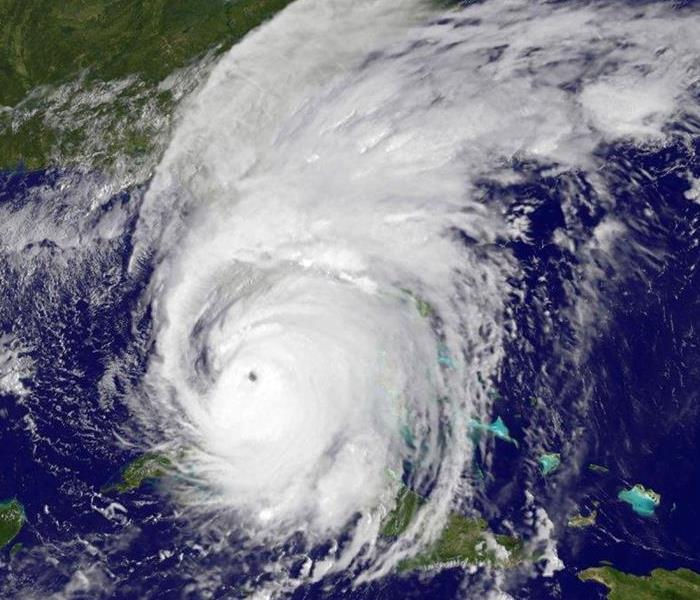 Having an emergency plan is important.
Having an emergency plan is important.
Make A Plan
Your family may not be together if a disaster strikes, so it is important to know which types of disasters could affect your area. Know how you’ll contact one another and reconnect if separated. Establish a family meeting place that’s familiar and easy to find.
Step 1: Put together a plan by discussing these 4 questions with your family, friends, or household to start your emergency plan.
- How will I receive emergency alerts and warnings?
- What is my shelter plan?
- What is my evacuation route?
- What is my family/household communication plan?
Step 2: Consider specific needs in your household.
As you prepare your plan tailor your plans and supplies to your specific daily living needs and responsibilities. Discuss your needs and responsibilities and how people in the network can assist each other with communication, care of children, business, pets, or specific needs like the operation of durable medical equipment. Create your own personal network for specific areas where you need assistance.
Keep in mind some these factors when developing your plan:
- Different ages of members within your household
- Responsibilities for assisting others
- Locations frequented
- Dietary needs
- Medical needs including prescriptions and equipment
- Disabilities or access and functional needs including devices and equipment
- Languages spoken
- Cultural and religious considerations
- Pets or service animals
- Households with school-aged children
Step 3: Fill out a Family Emergency Plan
Step 4: Practice your plan with your family/household
Volcanoes
5/31/2018 (Permalink)
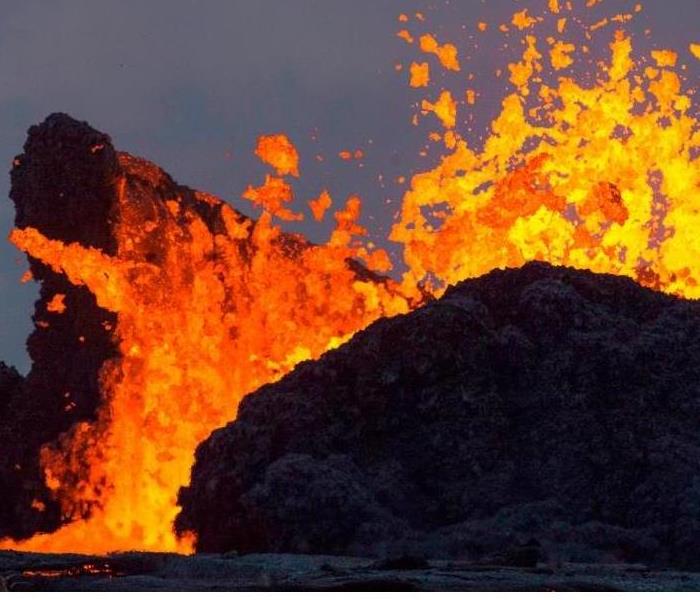 Volcano Eruption
Volcano Eruption
- A volcano is an opening in the Earth’s crust that allows molten rock, gases, and debris to escape to the surface. Alaska, Hawaii, California, and Oregon have the most active volcanoes, but other states and territories have active volcanoes, too. A volcanic eruption may involve lava and other debris that can flow up to 100 mph, destroying everything in their path. Volcanic ash can travel 100s of miles and cause severe health problems. A volcanic eruption can:
- Contaminate water supplies.
- Damage machinery.
- Reduce visibility through smog and harmful gases that may threaten low-lying areas.
- Make it hard to breathe and irritate the skin, eyes, nose, and throat.
IF YOU ARE UNDER A VOLCANO WARNING:
- Listen for emergency information and alerts.
- Follow evacuation or shelter orders. If advised to evacuate, then do so early.
- Avoid areas downstream of the eruption.
- Protect yourself from falling ash.
- Do not drive in heavy ash fall.
HOW TO STAY SAFE WHEN A VOLCANO THREATENS:
WHAT TO DO NOW: Prepare
- Know your area’s risk from volcanic eruption.
- Ask local emergency management for evacuation and shelter plans, and for potential means of protection from ash.
- Learn about community warning systems. The Volcano Notification Service (VNS) is a free service that sends notifications about volcanic activity. Sign up for alerts at https://volcanoes.usgs.gov/vns2/.
- Get necessary supplies in advance in case you have to evacuate immediately, or if services are cut off. Keep in mind each person’s specific needs, including medication. Do not forget the needs of pets.
- Consult your doctor if you have existing respiratory difficulties.
- Practice a communication and evacuation plan with everyone in your family.
- Have a shelter-in-place plan if your biggest risk is from ash.
- Keep important documents in a safe place. Create password-protected digital copies.
- Find out what your homeowner’s insurance policy will cover when a volcano erupts.
WHAT TO DO DURING: Survive
- Listen to alerts. The Volcano Notification Service provides up-to-date information about eruptions.
- Follow evacuation orders from local authorities. Evacuate early.
- Avoid areas downwind, and river valleys downstream, of the volcano. Rubble and ash will be carried by wind and gravity.
- Take temporary shelter from volcanic ash where you are if you have enough supplies. Cover ventilation openings and seal doors and windows.
- If outside, protect yourself from falling ash that can irritate skin and injure breathing passages, eyes, and open wounds. Use a well-fitting, certified facemask such as an N95. The Centers for Disease Control and Prevention (CDC) has a list of certified masks and the maker’s instructions on how to use the masks.
- Avoid driving in heavy ash fall. If you must drive, then turn off your vehicle’s headlights.
WHAT TO DO AFTER: Be Safe
- Listen to authorities to find out when it is safe to return after an eruption.
- Send text messages or use social media to reach out to family and friends. Phone systems are often busy after a disaster. Only make emergency calls.
- Avoid driving in heavy ash. Driving will stir up volcanic ash that can clog engines and stall vehicles.
- If you have any breathing problems, avoid contact with ash. Stay indoors until authorities say it is safe to go outside.
- Do not get on your roof to remove ash unless you have guidance or training. If you have to remove ash, then be very careful as ash makes surfaces slippery. Be careful not to contribute additional weight to an overloaded roof.
Hurricane Basics
5/31/2018 (Permalink)
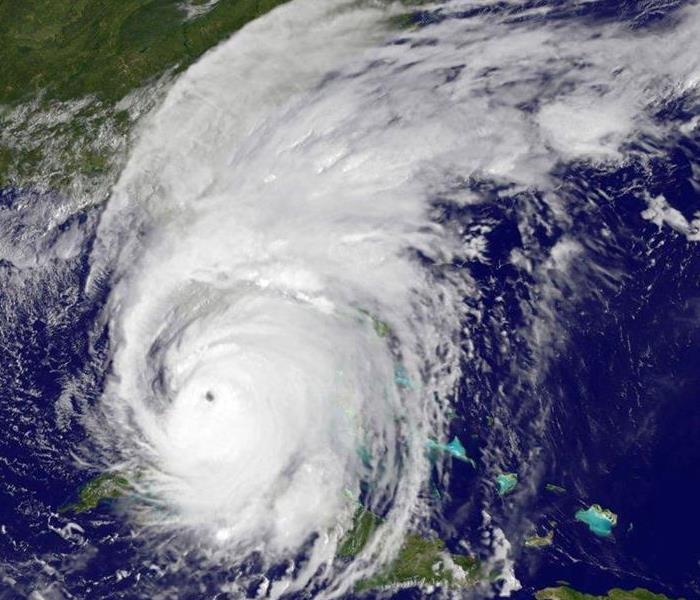 Hurricane Before Landfall
Hurricane Before Landfall
What
Hurricanes are massive storm systems that form over the water and move toward land. Threats from hurricanes include high winds, heavy rainfall, storm surge, coastal and inland flooding, rip currents, and tornadoes. These large storms are called typhoons in the North Pacific Ocean and cyclones in other parts of the world.
Where
Each year, many parts of the United States experience heavy rains, strong winds, floods, and coastal storm surges from tropical storms and hurricanes. Affected areas include all Atlantic and Gulf of Mexico coastal areas and areas over 100 miles inland, Puerto Rico, the U.S. Virgin Islands, Hawaii, parts of the Southwest, the Pacific Coast, and the U.S. territories in the Pacific. A significant per cent of fatalities occur outside of landfall counties with causes due to inland flooding.
When
The Atlantic hurricane season runs from June 1 to November 30, with the peak occurring between mid-August and late October. The Eastern Pacific hurricane season begins May 15 and ends November 30.
Basic Preparedness Tips
Know where to go. If you are ordered to evacuate, know the local hurricane evacuation route(s) to take and have a plan for where you can stay. Contact your local emergency management agency for more information.
Put together a go-bag: disaster supply kit, including a flashlight, batteries, cash, first aid supplies, medications, and copies of your critical information if you need to evacuate
If you are not in an area that is advised to evacuate and you decide to stay in your home, plan for adequate supplies in case you lose power and water for several days and you are not able to leave due to flooding or blocked roads.
Make a family emergency communication plan.
Many communities have text or email alerting systems for emergency notifications. To find out what alerts are available in your area, search the Internet with your town, city, or county name and the word “alerts.”
Preparing Your Home
Hurricane winds can cause trees and branches to fall, so before hurricane season trim or remove damaged trees and limbs to keep you and your property safe.
Secure loose rain gutters and downspouts and clear any clogged areas or debris to prevent water damage to your property.
Reduce property damage by retrofitting to secure and reinforce the roof, windows and doors, including the garage doors.
Purchase a portable generator or install a generator for use during power outages. Remember to keep generators and other alternate power/heat sources outside, at least 20 feet away from windows and doors and protected from moisture; and NEVER try to power the house wiring by plugging a generator into a wall outlet.
Consider building a FEMA safe room or ICC 500 storm shelter designed for protection from high-winds and in locations above flooding levels.
Hurricane Readiness
9/13/2017 (Permalink)
Preparing for a Hurricane:
• Prepare your evacuation plan, including pets, transportation routes and destinations.
• Keep all trees and shrubs well trimmed and clear loose and clogged rain gutters and downspouts.
• Determine how and where to secure your boat.
• Consider building a safe room.
• Stay informed! Listen to a NOAA weather radio or check local forecasts and news reports regularly.
• Cover your home’s windows with pre-cut plywood or hurricane shutters. Tape does not prevent windows from breaking.
• Bring in all outside furniture, decorations, garbage cans, etc.
• Turn off utilities if instructed to do so.
• Turn off propane tanks.
• Avoid using the phone, except for serious emergencies.
• Fill the bathtub or buckets with water to use for cleaning and flushing toilets.
• Keep your gas tank at least 3/4 full at all times.
• Keep your emergency supplies kit, including water, and copies of important documents, in a waterproof, portable container, in an easily accessible location
Evacuate under the following conditions:
• If local authorities tell you to evacuate, follow their directions.
• If you live in a mobile home or temporary structure, which are particularly hazardous no matter how well fastened to the ground.
• If you live in a high-rise building.
• If you live on the coast, on a floodplain, near a river, or on an inland waterway.
• If you feel you are in danger.
• If you live in an area below sea level.
Safety during Winter Storms
9/13/2017 (Permalink)
Winter storms can happen almost anywhere. They can cause us problems. Know what to do before, during and after a storm. This will help keep you and your family safe from a winter fire.
- Test all smoke alarms. Do this at least once a month. This way you will know they are working. Install carbon monoxide alarms in your home. Test the alarms.
- Plan two ways out of the home in case of an emergency. Clear driveway and front walk of ice and snow. This will provide easy access to your home.
- Make sure your house number can be seen from the street. If you need help, firefighters will be able to find you.
- Be ready in case the power goes out. Have flashlights on hand. Also have battery-powered lighting and fresh batteries. Never use candles.
- Stay aware of winter weather. Listen to the television or radio for updates. Watch for bulletins online.
- Check on neighbors. Check on others who may need help.
- Generators should be used outdoors. Keep them away from windows and doors. Do not run a generator inside your garage, even if the door is open.
- Stay away from downed wires. Report any downed wires to authorities.
- Be ready if the heat stops working. Use extra layers of clothes and blankets to stay warm. If you use an emergency heat source, keep anything that can burn at least 3 feet away.
- Turn portable heaters off when you leave the room. Turn them off when you go to bed.
When Storms or Floods hit Benicia/Martinez/Southeast Vallejo, SERVPRO is ready!
2/9/2017 (Permalink)
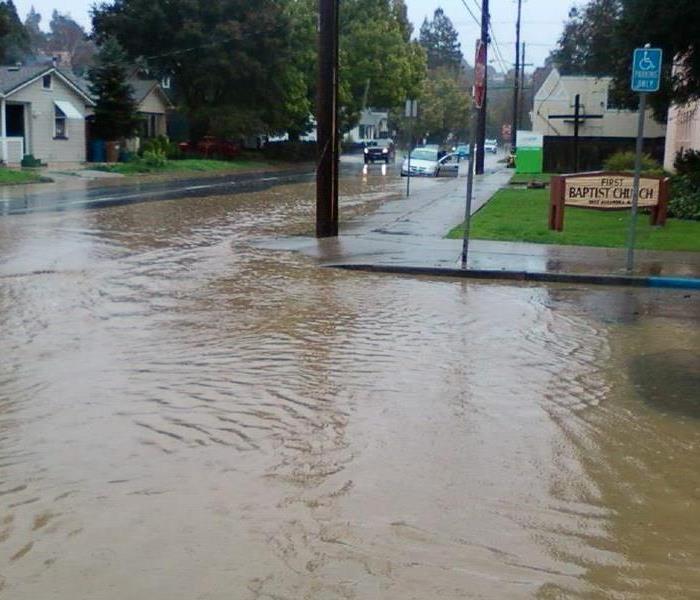 Our highly trained crews are ready to respond 24/7 to storm or flood damage in Benicia/Martinez/Southeast Vallejo.
Our highly trained crews are ready to respond 24/7 to storm or flood damage in Benicia/Martinez/Southeast Vallejo.
SERVPRO of Benicia/Martinez/Southeast Vallejo specializes in storm and flood damage restoration. Our crews are highly trained and we use specialized equipment to restore your property to its pre-storm condition.
Faster Response
Since we are locally owned and operated, we are able to respond quicker with the right resources, which is extremely important. A fast response lessens the damage, limits further damage, and reduces the restoration cost.
Resources to Handle Floods and Storms
When storms hit Benicia/Martinez/Southeast Vallejo, we can scale our resources to handle a large storm or flooding disaster. We can access equipment and personnel from a network of 1,650 Franchises across the country and elite Disaster Recovery Teams that are strategically located throughout the United States.
Have Storm or Flood Damage? Call Us Today 925-372-7234
Flood tips
1/12/2017 (Permalink)
 Downtown Martinez, CA
Jan. 2017
Downtown Martinez, CA
Jan. 2017
Floods are among the most frequent and costly natural disasters. Flooding often occurs following a hurricane, thawing snow, or several days of sustained rain. Flash floods occur suddenly, due to rapidly rising water along a stream or low-lying area. Learn what to do to keep your loved ones safe!
Prepare in Advance
Having sandbags in place can help tremendously in keeping water out of your house.
*Be sure to have them ready to go BEFORE the rains start.
Secure hazardous items
Roll up rugs, move furniture, electrical items and valuables to a higher level
Place important personal documents, valuables and vital medical supplies into a waterproof case in an accessible location
Staying informed about your community’s risk and response plans.
Remember: standard homeowners insurance doesn’t cover flooding but flood insurance does.
Staying Safe Indoors
Avoid contact with floodwater. It may be contaminated with sewage or contain dangerous insects or animals.
Don’t use gas or electrical appliances that have been flooded.
Dispose of any food that comes into contact with flood water .
Staying Safe Outdoors
Don't walk, swim or drive through floodwater. Just six inches of fast-flowing water can knock you over and two feet will float a car.
If caught on a flooded road with rapidly rising waters, get out of the car quickly and move to higher ground.
Don’t allow children to play in or near flood water.
Avoid contact with floodwater. It may be contaminated with sewage or contain dangerous insects or animals.
Stay out of areas subject to flooding. Underpasses, dips, low spots, canyons, washes, etc. can become filled with water.
SERVPRO Of Benicia/Martinez/Southeast Vallejo is here to help clean up and dry out your affected properties. Call us at 925-372-7234





 24/7 Emergency Service
24/7 Emergency Service








